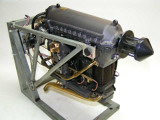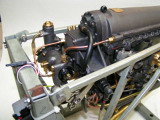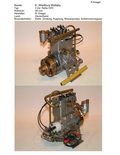Model Engine Gallery Page 6
Click on the images to view them larger size.



|
Assembly time for Brian Perkins' Bristol Hydra, photos of which have appeared all over the place here. Use the Site Search page and search on Hydra to find them all. Brian says: I have finally run out of things to make and excuses, so I have started putting the beast together. I have managed to get the rear cover and supercharger together and all the gear drives seem to be doing what they should after a certain amount of fiddling, but then I came to put the crankshaft into the crankcase. The master rods have to be assembled onto the crank before it is installed to allow for the three piece crankshaft to be aligned and the maneton bolts clamped up, but then you are faced with having to get the whole assembly into the crankcase and the only way in is through the front end bore which is only 3-3/8" dia. Something of a Chinese puzzle but as you will see from the third photo. it did eventually go in. It must have been quite interesting assembling the full size. Now I just have to get the slave rods connected and I can start worrying about the cylinders and valve gear. I think I have said before that I feel that putting the thing together is going to be far more difficult than making all the bits and I am beginning to think that the chap at the Heritage Trust may have had a point when he asked me if I thought I would live long enough!!! |
||||||||||||||||||||||||||||||||||||||






|
Quick! Someone hide my checkbook, please! You are looking at a scale model of the de Havilland Gipsy Major Mk I—the engine that powered the original DH82 Tiger Moth. About the only thing saving me from taking the plunge is the size of this thing. At the rather unusual scale of 1:3.5, it's a BIG brute, massing about 7kg (14.4 pounds) dry and spins a 26" diameter prop. The castings and plans come from Reinhold Krieger. A mere 800 Euros will get you all the castings shown in the first photograph, plus full plans. I've not seen these, but they are doubtless metric, and probably notated in German as well. Here is what we do know about the engine:
The attention to detail is outstanding. For instance, look at the stamped strengthening ridges on the heat shield between the carby and the cylinders. If you would like a set of castings, email Reinhold at re.kreiger@t-online.de. At the time these pictures were posted (July 2005), Reinhold has completed five (yes, 5!) of these engines and is willing to sell three to fund new projects. |
||||||||||||||||||||||||||||||||||||||






|
But wait! etc... More engine pictures from Reinhold Krieger in Germany. The ones that show two views with text are at the top are samples from a CD he has put together containing information on over 350 4-stroke engines. Some are commercial products, but most are built by home constructors. The ones seen here from top to bottom are:
The last two pictures are of a Holt 75 Catapillar engine built from Coles castings. Like his Gipsy above, Reinhold made multiples of this engine and wishes to sell one to finance further projects. The email link to Reinhold was given above in the Gipsy entry, but if you wish, you can write or telephone him (his English is far better than my German!):
Reinhold Krieger Hanauer Weg 7 D-40227 Düsseldorf Germany Phone: 0049 211 787569 Mail: re.krieger@t-online.de |
||||||||||||||||||||||||||||||||||||||




|
The engines in these pictures were made by Siegfried Fleischmann, another talented model engineer from Bavaria, Germany. The first uses the liner and from Webra MACH1, but the rest is Siegfried's work. Initially we thought he had used heads with the dreaded multi-grip plier marks on the fins, but closer inspections shows that the central two fins appear to have been knurled to provide a grip for finger tightening it onto the liner. If this is correct, it is most unusual and quite practical. In total, Siegfried has made seven twins to this general pattern; six diesels and a glow. Not so obvious in the second photograph is that fact that two have rotary disk induction, while the rest utilize drum induction. The liners are from Webra MACH1 and JENA engines (2.0 and 2.5cc). The engines may resemble a MACH1 Webra in profile, but they are 5 mm longer. The cases are sandcast in oil-bonded sand with Krupp ALM 4 Duralaluminium. The cylinders are in line axially, but the conrods are staggered to provide simultaneous firing. The crankshafts are supported by three roller bearings and are fabricated by pressing three parts together. The middle part carries both of the crankpins. Siegfried does not say, but I think it safe to assume that one-piece conrods are used, fitted before assembling the crankshafts. All in all, a well though out design, beautifully executed. The last photographs show Siegfried's Cox-based two-stroke radials. The engines use Cox .049 cylinders and pistons, except for the piston carrying the master-rod. Crankcase charging is provided by an Italian Fiamm centrifugal blower (electric) intended for air-horns. On one engine this is modified to be driven by the crankshaft. Siegfried reports that it develops a gas pressure of about 0.4 bar. The Webra carb provides a speed range between 2,000 and 10,000 rpm and the engine is wonderfully loud. |
||||||||||||||||||||||||||||||||||||||

|
This one pushes nearly all of my current hot-buttons. It's a twin (button permanently engaged), it's a diesel (ditto), and it's a four-stroke (ok, I could be more turned on if it was side-valve, but still...) The engine was made by yet another talented English model engineer, Phil Cox. Phil, who is now well into his 70's was as a toolmaker at Rolls-Royce. Not only does he build engines for his beautifully made free flight models—which explains the small tank on the twin—he also made the lathe that he builds the engines on! Four-stroke diesels are relatively rare, but appear to work quite well. The adjustable compression devices on this engine comprise a stack of PTFE and steel disks in a reduced bore section of the heads. The photo was taken by Ken Croft who also supplied the details, noting that the displacement is probably about 5cc and that Phil Cox is a gentleman of the first order. |
||||||||||||||||||||||||||||||||||||||



|
Here's another model engineering masterpiece from Siegfried Fleischmann. This time the topic is a rather rare Oliver Tiger intended for teather-car racing (where Olivers first made their appearance, although today the team-race models are better known). I'll let Siegfried explain: Maybe you remember the two cars sold in Miquel's auction in London. Miquel's cars are the only ones I ever saw, but in Italy, the Oliver and some Vega cars are being reproduced and I bought two unmachined bodies from Italian collectors. The Raylite tyres are available in Hungry. With help from John Goodall´s book, finishing the cars was no problem, but the engines!!!! Here in central Europe there is no chance of finding an original twinshaft engine, or even a copy. But I'm fortunate to have some very good friends. A tether driver in Munich loaned me his engine. It was a lot of work to produce the four Olivers. I think I spent nearly fifty hours per engine! But the finished cars are so wonderful. The silver one is a Mercedes W 165 from 1938. The red is a Alfetta 158 from 1959 is modelled on the one driven by Fangio. The engines were made to the original dimensions and the cases cast in oil bonded sand. The pistons are made from GGG40 material (40kp/qmm Grauguss); the liners and crankshafts are made from ETG100 Swiss Steel. In a later email Siegfried mentioned that he case-hardened the liners, but ETG100 was quite hard enough to be used as machined for the crankshafts. Siegfried can be contacted at Siegfried.Fleischmann1@nefkom.net. |
||||||||||||||||||||||||||||||||||||||



|
These photos were sent in by Ed Solenberger of Santa Rosa, California. The engines here are a Battiwallah and a Book. I commented on the screw-in backplate of the Batti, knowing that it was a deviation from the plan. Here's Ed's comments: Seems like Murphy's law went into effect when I was going into the back end—a wee spot of light appeared—how could that happen? Anyhow, the threaded in back plate is one of my favorite things to do. This engine is really a joy as it starts easily and runs at a wide range of compression settings. Starting routine consists of one finger choke - a squirt on the closed piston and off it goes!!! Vincent's casting is a joy to machine. The other photos show my version of Bob Pelfrey's Book .60. He said this was the 3rd one of these, but the 7th casting. Al Book wanted the engines to be numbered by the casting, not the order—So this is 007!! Old McCoy front with a Hornet shaft, K&B 61 piston/cyl. and head. My rod and rear end with Delron rotor. Very strong runner—mounts drilled as McCoy—may try flying it, but it will have to be in a new model, as I doubt my 18 year old Lanzo Bomber could stand it! |
||||||||||||||||||||||||||||||||||||||

|
Here we have a replica of the 0.5cc Allbon Dart made by Mark Lester (England). As you can see, Mark hogged the crankcase from a solid lump in a very good approximation of the die cast Dart case. He has had to omit the web between the venruri and cylinder base, which is quite understandable. Mark reports that he made everything except the spraybar nut and that while the finish is not brilliant, it runs well. This is a good example of what a little determination will accomplish. The finish could be addressed with a little sand blasting, but the engine was built to run, not look at, so this is not of great importance. Mark's current project is a Nano. |